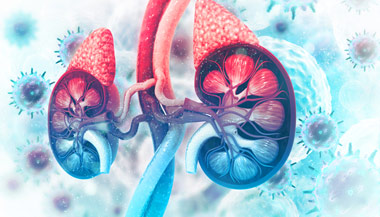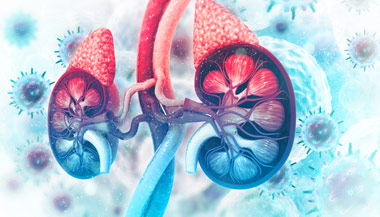Introduction to Menopause
What is menopause?
When a woman permanently stops having menstrual periods, she has reached the stage of life called menopause. Often called the change of life, this stage signals the end of a woman's ability to have children. Many healthcare providers actually use the term menopause to refer to the period of time when a woman's hormone levels start to change. Menopause is said to be complete when menstrual periods have ceased for one continuous year.
The transition phase before menopause is often referred to as perimenopause. During this transition time before menopause, the supply of mature eggs in a woman's ovaries diminishes and ovulation becomes irregular. At the same time, the production of estrogen and progesterone decreases. It is the big drop in estrogen levels that causes most of the symptoms of menopause.
When does menopause occur?
Although the average age of menopause is 51, menopause can actually happen any time from the 30s to the mid-50s or later. Women who smoke and are underweight tend to have an earlier menopause, while women who are overweight often have a later menopause. Generally, a woman tends to have menopause at about the same age as her mother did.
Menopause can also happen for reasons other than natural reasons. These include:
-
Premature menopause. Premature menopause may happen when there is ovarian failure before the age of 40. It may be associated with smoking, radiation exposure, chemotherapeutic drugs, or surgery that impairs the ovarian blood supply. Premature ovarian failure is also called primary ovarian insufficiency.
-
Surgical menopause. Surgical menopause may follow the removal of one or both ovaries, or radiation of the pelvis, including the ovaries, in premenopausal women. This results in an abrupt menopause. These women often have more severe menopausal symptoms than if they were to have menopause naturally.
What are the symptoms of menopause?
These are the most common symptoms of menopause. However, each woman may experience symptoms differently. Some have few and less severe symptoms, while others have more frequent and stressful ones. The signs and symptoms of menopause may include:
Hot flashes
Hot flashes or flushes are, by far, the most common symptom of menopause. About 75% of all women have these sudden, brief, periodic increases in their body temperature. Usually hot flashes start before a woman's last period. For 80% of women, hot flashes occur for 2 years or less. A small percentage of women experience hot flashes for more than 2 years. These flashes seem to be directly related to decreasing levels of estrogen. Hot flashes vary in frequency and intensity for each woman.
In addition to the increase in the temperature of the skin, a hot flash may cause an increase in a woman's heart rate. This causes sudden perspiration as the body tries to reduce its temperature. This symptom may also be accompanied by heart palpitations and dizziness.
Hot flashes that happen at night are called night sweats. A woman may wake up drenched in sweat and have to change her night clothes and sheets.
Vaginal atrophy
Vaginal atrophy is the drying and thinning of the tissues of the vagina and urethra. This can lead to pain during sex, as well as vaginitis, cystitis, and urinary tract infections.
Relaxation of the pelvic muscles
Relaxation of the pelvic muscles can lead to urinary incontinence and also increase the risk of the uterus, bladder, urethra, or rectum protruding into the vagina.
Cardiac effects
Intermittent dizziness, an abnormal sensation, such as numbness, prickling, tingling, and/or heightened sensitivity, cardiac palpitations, and fast heart rhythm may occur as symptoms of menopause.
Hair growth
Changing hormones can cause some women to have an increase in facial hair or a thinning of the hair on the scalp.
Mental health
Mood changes are common during menopause and can range from being mild to severe. In some instances, a woman can experience severe anxiety which feels like panic. Depression, irritability, lack of interest and sentiments of "I just don't feel like myself" are often expressed by women with menopause.
Vasomotor symptoms and sleep disturbance can be related to mood changes. In the case of a woman experiencing severe night sweats causing sleep disturbance, she can also experience brain fog. Brain fog symptoms includes lack of focus, confusion and forgetfulness and can be distressing, especially in the setting of work performance.
What can I do about hot flashes?
Hot flashes occur from a decrease in estrogen levels. In response to this, your glands release higher amounts of other hormones that affect the brain's thermostat, causing your body temperature to fluctuate. Hormone therapy has been shown to relieve some of the discomfort of hot flashes for many women. However, the decision to start using these hormones should be made only after you and your healthcare provider have evaluated your risk versus benefit ratio.
Practical suggestions for coping with hot flashes include:
-
Dress in layers, so that you can remove clothing when a hot flash starts.
-
Avoid foods and beverages that may cause hot flashes, like spicy foods, alcohol, coffee, tea, and other hot beverages.
-
Drink a glass of cold water or fruit juice when a hot flash starts.
-
Reduce your stress level. Stress may worsen hot flashes.
-
Keep a thermos of ice water or an ice pack next to your bed during the night.
-
Use cotton sheets, lingerie, and clothing that allow your skin to breathe.
-
Keep a diary or record of your symptoms to find what might trigger your hot flashes.
Treatment for menopause
Several therapies that help to manage menopause symptoms including:
Hormone therapy (HT)
Hormone therapy (HT) involves the taking a combination of the female hormones estrogen and progesterone during perimenopause and menopause. HT is most commonly prescribed in pill form. However, estrogen can also be given by using skin patches and vaginal creams.
The decision to start using these hormones should be made only after you and your healthcare provider discuss the risks and benefits.
Estrogen therapy (ET)
Estrogen therapy (ET) involves taking estrogen alone, which is no longer being made by the body. ET is often prescribed for women who have had a hysterectomy. Estrogen is prescribed as pills, skin patches, and vaginal creams.
The decision to start using this hormone should be made only after you and your healthcare provider discuss the risks and benefits.
Non-hormonal treatment
This type of treatment often involves the use of other types of medicines to relieve some of the symptoms associated with menopause.
Estrogen alternatives
Estrogen alternatives are the so-called "synthetic estrogens," like ospemifene, improve symptoms of vaginal atrophy without affecting endometrial cancer risk.
Alternative therapies
Homeopathy and herbal treatments, often called bioidentical hormones, may offer some relief from some symptoms of menopause. However, there are concerns about potency, safety, purity, and effectiveness.





